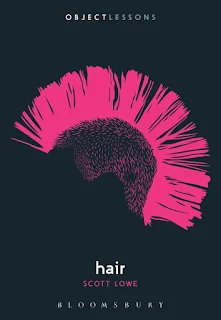Hair by Scott Lowe is from the Object Lessons series of books by Bloomsbury Academic, and I borrowed this copy from the library.
"So, the way hair is dyed, shaped, managed, neglected, restrained, or set free always has meaning. Hair is vexing and it is complex. Everyone has opinions about hair, so naturally the world's religious traditions have a great deal to say about it." Pages 12-13Lowe goes on to say:
"Hair may be social or private, trendy or deliberately uncool, serious or ironic; hair is geographical, ethnic, and biological, but above all, I think it's religious." Page 14Having taught religious studies for 30 years, Scott Lowe informs the reader early on that he is going to narrow his focus and present the religious aspects of hair in this book. Was I disappointed on learning this? You bet! Did I feel as though I wasn't going to get the full picture? Absolutely! However, the author still managed to hold my attention and teach me something new, like the fact that Muslim men remove their armpit and pubic hair.
"Modern Muslim men continue to practice a limited form of body depilation, removing only armpit and pubic hair. Torso, arm, and leg hair is usually left undisturbed. Head hair is neatly trimmed and kept short, beards are also trimmed but usually long." Page 46Lowe points out that some religions use hair and dress to differentiate themselves from Muslims and other religions. Sikhs wear 'full moustaches, extravagant beards and often enormous turbans' and Hindus have short hair, heavy moustaches and no beards. Other religions and hairstyles were presented, including a topic of interest, the tonsure. A variety of interpretations for the shaven head were also revealed.
"A shaven head indicates disgrace or shame when used as a punishment, yet a similar hairless head might signify controlled rage on a White supremacist, self-confident power on a CEO, dedication to a life of celibacy on a Buddhist monk, a recent life transition on a Hindu, and mourning on a Lakota. It's complex." Page 122The covering of women's hair for religious purposes is included, and wimples, hijabs, veils and wigs are touched on briefly, along with the history of blonde and red hair in men and women.
In an introduction to styling, Lowe piqued my interest with the following:
"In every epoch for which we have evidence, humans have employed enormous creative energy to devise new and distinctive hairstyles. From braiding to perming to tying hair onto massive wire and wood superstructures, powdering, flouring - before the French revolution put an end to that wasteful practice, French aristocrats purportedly used enough flour on their wigs every month to make thousands of loaves of bread - shaving, sculpting, lacquering, coloring, curling, gilding, waxing, primping, ratting, the list goes on and on." Page 69Unfortunately for this reader, Lowe doesn't expand on any of these tantalising hairstyles, and much is left unexplored in favour of the focus on religion.
Ironically, Lowe had time in the book to touch on the strange custom of eighteenth-century British lovers who 'give each other clippings of their pubic hair' and the Victorian custom of mourning jewellery containing a lock of hair from a deceased loved one. With only three pages given to African-American hair and hairstyles, these were all topics I was eager to explore but will need to do so elsewhere.




































